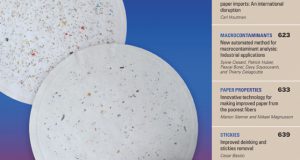
 The papers summarized here are from the April 2017 issue of TAPPI Journal and the May 2017 issue, featuring peer-reviewed content from TAPPI’s 2016 PEERS conference. TAPPI Journal is an online publication of relevant and timely peer-reviewed research delivered via email and free to all TAPPI members. To receive TAPPI Journal, join TAPPI at www.tappi.org.
The papers summarized here are from the April 2017 issue of TAPPI Journal and the May 2017 issue, featuring peer-reviewed content from TAPPI’s 2016 PEERS conference. TAPPI Journal is an online publication of relevant and timely peer-reviewed research delivered via email and free to all TAPPI members. To receive TAPPI Journal, join TAPPI at www.tappi.org.
APRIL
NANOTECHNOLOGY
Novel thin functional coatings for paper by foam coating
Karita Kinnunen-Raudaskoski, Tuomo Hjelt, Ulla Forsström, Patrizia Sadocco, and Jouni Paltakari
Conventional coating methods are currently being challenged by newly developed technologies that can result in products with interesting properties and competitive prices. Versatile foam coating is one such promising technology. Foam coating is carried out using different foam application methods, and the viscoelastic nature of the foam allows the use of a large variety of materials.
In this study, paper was coated with nanomaterials on a pilot scale using a method based on slot die application combined with foam destruction by absorption and infrared drying. A thin layer of titanium dioxide/zinc oxide (TiO2/ZnO) functionalized cellulose nanofibrils (CNF) creates antimicrobial properties in the paper, and a thin layer of CNF-TiO2 alone has substantial ability to oxidize nitric oxide (NO) and nitrogen oxides (NOx). These results illustrate methods that can be used to create novel functional properties for different end-use applications. Thin functional layers could bring added value to current products and also create opportunities to introduce novel products for several industrial areas using web-type manufacturing processes.
illustrate methods that can be used to create novel functional properties for different end-use applications. Thin functional layers could bring added value to current products and also create opportunities to introduce novel products for several industrial areas using web-type manufacturing processes.
LIGNIN PRODUCTS
Recent advances in lignin-based polyurethanes
Yun-Yan Wang, Charles M. Cai, and Arthur J. Ragauskas
Given the rise in demand for sustainable renewable biofuels and promising developments in cellulosic ethanol, the valorization of lignin has become essential for biorefining operations, especially with today’s low-cost energy production state of affairs. In the past 40 years, numerous efforts have been devoted to incorporating lignin and lignin derivatives into commercial polymeric materials. One of the promising strategies is to use multifunctional lignin macromolecules or oligomers as the replacement of polyols during polyurethane synthesis.
In this review, the authors examined recent advances in fabricating polyurethane foams, films, and adhesives with modified or unmodified lignins. The mechanical and thermal properties of these lignin-based polyurethanes were correlated to their formulations, lignin molecular weight, and polydispersity, as well as the structural features of different lignin preparations. Recalcitrance and strong intermolecular interactions of lignin macromolecules are known to prevent them from effective incorporation into other polymeric materials, covalently or noncovalently. Therefore, this review intends to summarize the methods that improve the reactivity of lignin through chemical modification such as depolymerization, demethylation, and chain extension. The authors examined future developments and applications with a special emphasis on tailoring lignin structure to specific applications.
PULPING
In-process detection of fiber cutting in low consistency refining based on measurement of forces on refiner bars
R. Harirforoush, J. Olson, and P. Wild
A major drawback of low consistency refining is the degradation of mechanical properties due to fiber cutting at high refining energies. Conventional strategies to avoid fiber cutting are based on post-refining measurement of pulp properties and, typically, this does not enable rapid adjustment of refiner operation in response to the onset of fiber cutting.
 This study’s objective is to detect the onset of fiber cutting with custom-designed piezoelectric force sensors that measure shear and normal forces applied to pulp fibers by the refiner bars. Researchers performed trials in an AIKAWA/Advanced Fiber Technologies Inc. 16-in. single-disc low consistency refiner. The trials were run using mechanical softwood SPF (spruce, pine, and fir) pulp with 378 ml CSF at 2.5 percent and 3.5 percent consistency at rotational speeds of 800 rpm, 1000 rpm, and 1200 rpm. Distributions of the peak normal and shear forces and peak coefficient of friction were determined for each operating condition, and a two-parameter Weibull function fit to each of these distributions. Researchers calculated the scale parameter, one of the key parameters of the Weibull function, and plotted length-weighted fiber length as a function of this parameter.
This study’s objective is to detect the onset of fiber cutting with custom-designed piezoelectric force sensors that measure shear and normal forces applied to pulp fibers by the refiner bars. Researchers performed trials in an AIKAWA/Advanced Fiber Technologies Inc. 16-in. single-disc low consistency refiner. The trials were run using mechanical softwood SPF (spruce, pine, and fir) pulp with 378 ml CSF at 2.5 percent and 3.5 percent consistency at rotational speeds of 800 rpm, 1000 rpm, and 1200 rpm. Distributions of the peak normal and shear forces and peak coefficient of friction were determined for each operating condition, and a two-parameter Weibull function fit to each of these distributions. Researchers calculated the scale parameter, one of the key parameters of the Weibull function, and plotted length-weighted fiber length as a function of this parameter.
The results show that the onset of fiber cutting consistently corresponds to a distinct transition in the plot of length-weighted fiber length versus scale parameter. This transition is believed to be caused by a fundamental transition in the fiber-bar interaction. Moreover, frequency analysis of the sensor data shows the magnitude of the dominant frequency remains relatively constant while the plate gap is reduced, up to a threshold value, which corresponds to the onset of fiber cutting. The results suggest that these sensors have potential to be used for in-process detection of the onset of fiber cutting.
MAY
BIOREFINERY
Process for producing acetic acid in hardwood kraft pulp mills
Ravikant Patil, Joseph Genco, Hemant Pendse, and Adriaan Van Heiningen
To determine the economic feasibility of producing acetic acid from commercial hardwood chips in kraft pulp mills, researchers conducted laboratory experiments to obtain data for a preliminary economic analysis of an acetic acid recovery process. The acetyl groups in northeast hardwood were hydrolyzed from the xylan polymers in the wood to obtain sodium acetate, and extraction experiments involved use of sodium hydroxide at low temperature. Sodium acetate from the extract was concentrated and then converted into acetic acid and sodium hydroxide by salt splitting using bipolar membrane electrodialysis (BPMED). Researchers prepared flow diagrams and made cost estimates for capital and operating costs of the proposed acetic acid recovery process. The discounted cash flow rate of return on investment was estimated 1000–2000 tpd pulp mills.
Preliminary economic analysis showed that the discounted cash flow rate of return on investment is primarily a function of (1) plant size, (2) acetic acid selling price, and (3) content of acetyl groups in the wood species. Income for the process and the rate of return on investment increases with increasing acetyl content in the wood and selling price of the acetic acid. When food grade acetic acid is produced, for example, the rate of return could be between 9  percent and 16 percent, depending on pulp mill size.
percent and 16 percent, depending on pulp mill size.
A process to recover acetic acid or acetate salt as a byproduct of kraft pulp mills will be useful to scientists and engineers who are developing the biorefinery concept.
PULPING
Determining wash loss levels in the brownstock pulp washing line using different methods
Riku Kopra and Olli Dahl
The performance of brownstock washing can be described in two ways: using wash loss, which describes the amount of washable compounds in the pulp suspension that could have been removed in washing; or the dilution factor, which represents the net amount of water that is added during washing. The amount of sodium in the pulp suspension after washing has typically been used as an indicator of wash loss. Other common measurement methods are conductivity, chemical oxygen demand (COD), total organic carbon (TOC), dissolved dry solids (DDS), and lignin concentration.
This study examined a Scandinavian pulp mill’s softwood and hardwood fiber lines using various measurement methods in the pulp phases to better understand wash loss. The DDS concentration in the streams was measured with a refractometer and laboratory scale. The pH, conductivity, lignin content, TOC, and COD were measured to find any correlations. Using different methods, the level differences remain constant, but it is difficult to control washing with sufficient precision using individual measurements. The measurement methods must also be continuous and reliable for use in the monitoring and control of washing. Proper measurement techniques can help mills detect a wash line’s problem areas; predict wash efficiency in real-time; and control washers’ operation, water usage, and chemical consumption, which directly impact the economics of other processes.
Other research appearing in TAPPI Journal’s April 2017 issue:
ECONOMIC ANALYSIS
Decision-making process for the identification of preferred lignin-based biorefinery strategies
Cédric Diffo Téguia, Sophie D’Amours, Rod Albers, and Paul Stuart
LIGNIN PYROLYSIS
Toward valorization of lignin: Characterization and fast pyrolysis of lignin recovered from hot-water extracts of electron-beam irradiated sugar maple
Derek Corbett, Ofei Mante, and Biljana Bujanovic
Other research appearing in TAPPI Journal’s May 2017 issue:
BLEACHING
Generalized steady-state model for chlorine dioxide brightening of hardwood kraft pulps
Brian N. Brogdon
PULPING
Impact of dissolved matter in the oxygen delignification stage
Caroline Wilke, Niclas Andersson, and Ulf Germgård
Narrow slot-type foam coating applicator.
Lignin-polyurethane patents published worldwide in the past 30 years.
(a) Refiner force sensor used;
(b) closeup of sensor installed in the stator;
(c) location of the sensor on the stator plate.
Arrangement of ion-exchange membranes in BMPED cell.
 Paper 360
Paper 360


